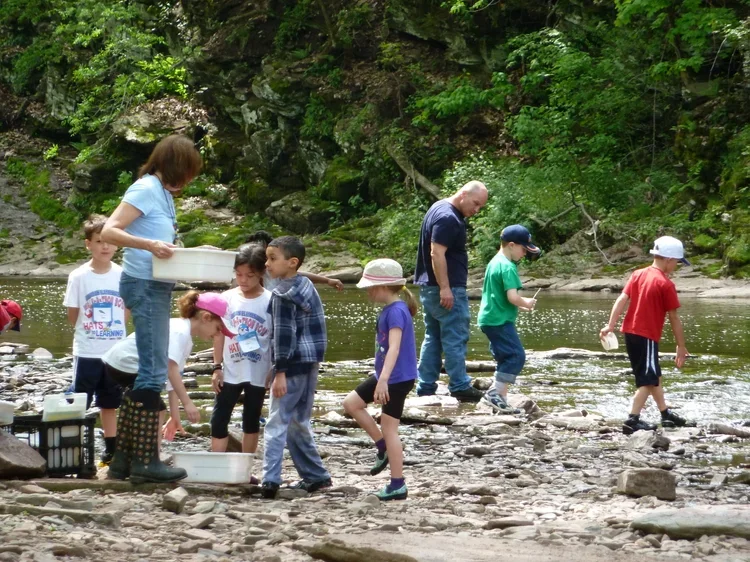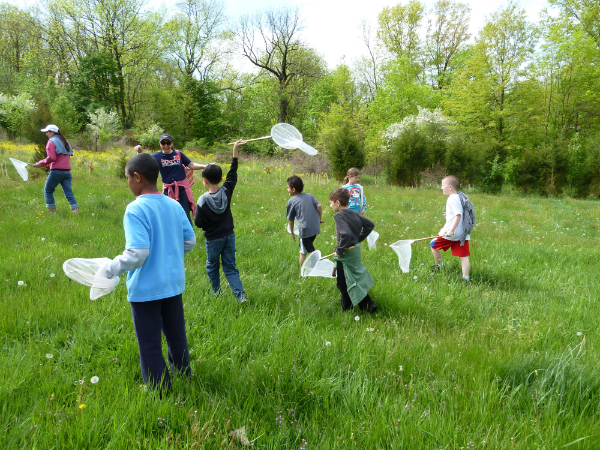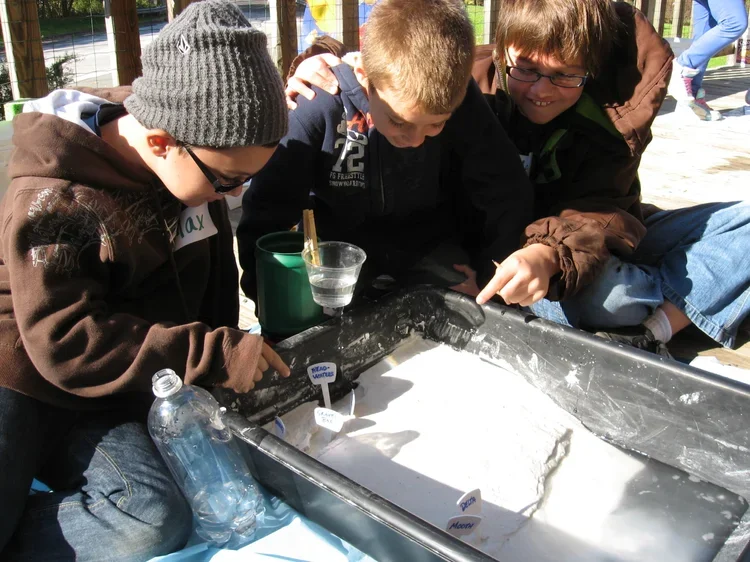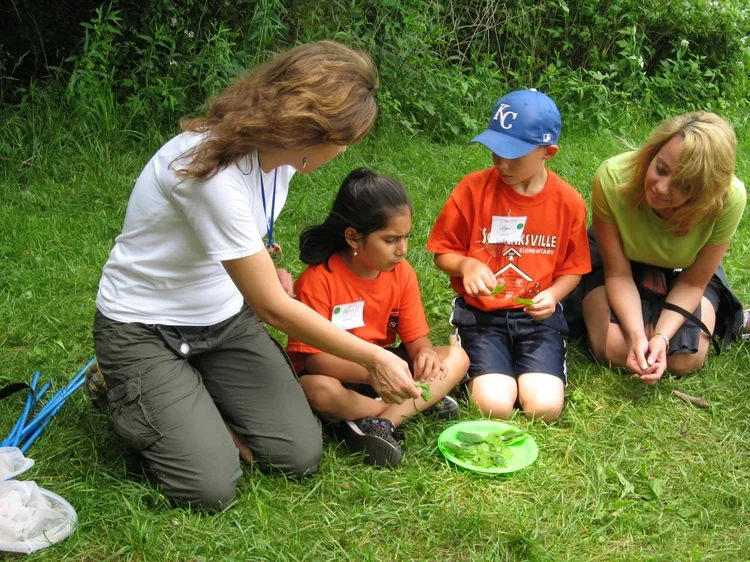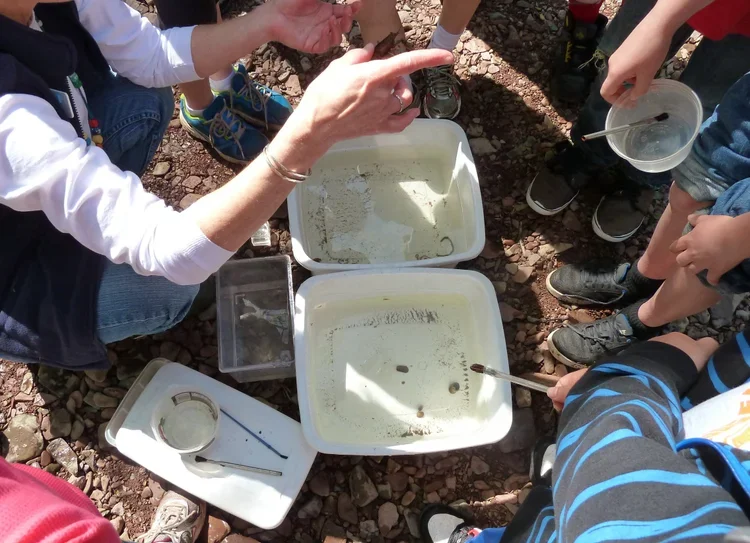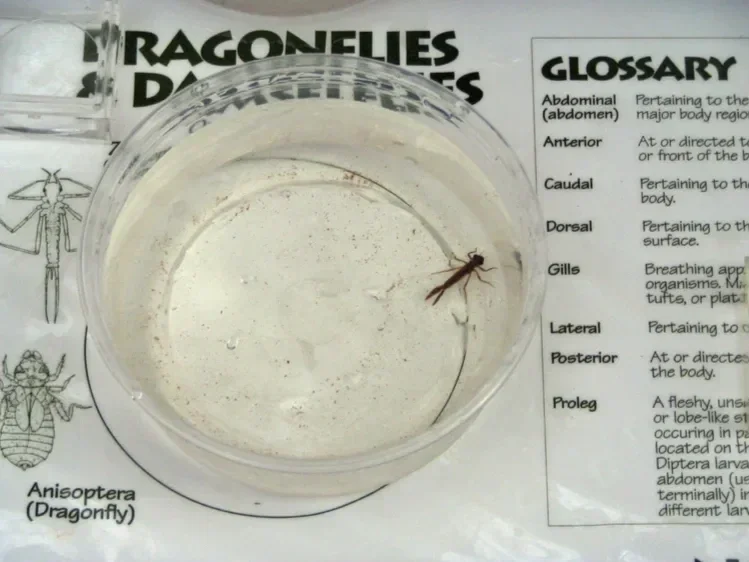
Programs for 1st - 5th Grade
Stream Investigations
Recommended for grades 4 - 6
Combine research with personal field observations! Students hike through the riparian buffer forest to the beautiful East Branch creek where they assess the life-sustaining components of the stream community, collect and identify macroinvertebrate specimens, and trace the flow of energy. After a lunch break in our picnic facilities, students play a game that teaches new information and reinforces important vocabulary and concepts. A microscope session allows students to see a variety of aquatic organisms larger than life, identify the special features which help them to survive, learn more about their life cycles and how they can be used to determine stream health.
Booking & Pricing
$16.00 per student ($160 minimum fee per class)
Full day program, approximately 4 hours and 15 minutes in length
Field & Stream Communities
Recommended for grades 2 - 3
One of our most popular programs! Two lessons combined into one fun filled full day at the Conservancy!
Exploring Field Communities:
Out of our “magic bag” come the four abiotic essentials needed to support life in the field community. With these in tow we take off on a consumer hunt, identify the producers, “Get Down!” with the decomposers, and make mini-communities of our own! A great opportunity to support classroom learning "in the field!"
Introduction to Stream Communities:
Travel to the East Branch Creek and uncover the secrets of life in a stream community. How does the energy needed to sustain life travel through this community? Good question! We’ll find out as we meet a variety of animals, get our boots wet, search for animal homes, and investigate this remarkable watery environment!
Booking & Pricing
$16.00 per student, only offered at Conservancy
Full day program, approximately 4 hours and 15 minutes in length
Recommended for grades 4 - 6
How did that stream get there? Using hands-on activities, students determine the factors involved in stream formation, including water source, substrate, incline, velocity, and turbidity. We then journey to the East Branch Creek to identify how these factors influenced the formation of the stream.
Booking & Pricing
$10.00 per student ($160 minimum fee per class)
Half day program, approximately 1 hour 45 minutes in length
Stream Morphology
Recommended for grades 4 - 6
Using topographic maps, a large floor map of the Perkiomen Creek Watershed, and their current knowledge base, students will develop an understanding of what a watershed is and how its boundaries are determined, and why "what you do to the land, you do to the water". Students will identify major tributaries of the Perkiomen Creek, find out who lives in a watershed, and discover their own “watershed address”.
Booking & Pricing
$8.00 per student plus a $10 Travel & Transportation fee per class when held at your classroom
$7.50 per students when held at the Conservancy
Approximately 1 hour in length
Intro to Watersheds
Human Impact & Sustainable Solutions
Recommended for grades 4 - 6
Herbicides, pesticides, oil, gas, and soil erosion all impact the health of the watershed in which we live. Where does it all come from, and what alternatives, or best management practices, are available to ensure a lighter more sustainable interaction with our watershed ecosystems? During this presentation students make hypotheses, and conduct experiments to determine the effects of our everyday practices on land and water resources and learn about best management practices designed to mitigate the effect on water quality.
Booking & Pricing
$10.00 per student plus a $10 Travel & Transportation fee per class when held at your classroom
$8.50 per students when held at the Conservancy
Approximately 1 and 1/2 hours in length
Intro to Field Communities
Recommended for grades 2-3
Students journey into the field to learn about the field ecosystem, communities, and energy flow through the food web. Out of our “magic bag” come the four abiotic essentials needed to support life in the field community. With these in tow we take off on a consumer hunt, identify the producers, “Get Down!” with the decomposers, and make mini-communities of our own! A great opportunity to support classroom learning “in the field”!
Booking & Pricing
$10.00 per student ($100 minimum fee per class)
Approximately 1 hour and 45 minutes in length
Intro to Stream Communities
Recommended for grades 2-3
All eyes, all the time on the members of the East Branch stream community! We'll put on our water shoes, search for animal homes, and investigate this remarkable watery environment. Following a hike through the woods, we arrive at our gravel bar destination where we will learn how to carefully move through the water locating our creek buddies as we explore their habitat.
Booking & Pricing
$10.00 per student ($100 minimum fee per class)
Approximately 1 hour and 45 minutes in length
Animal Adaptations
Recommended for grades 2-5
Every animal has special features which help it to survive. Together we explore the physical and behavioral attributes of birds, mammals, and insects. Students participate in experiments, view mounted specimens, examine natural history artifacts, and engage in unique activities! (This half-day class may be combined with another, to create a full-day trip to the Conservancy!)
Booking & Pricing
$10.00 per student plus a $10 Travel & Transportation fee per class when held at your classroom
$8.50 per student when held at the Conservancy
Approximately 1 hour and 45 minutes in length
For more information about these programs or to make a reservation, contact education@perkiomenwatershed.org
PA STEELS Standards addressed in lesson include:
3.1.5.A Support an argument that plants get the materials they need for growth chiefly from air and water.
3.1.6-8.K Develop a model to describe the cycling of matter and flow of energy among living and nonliving parts of an ecosystem.
3.3.5.E Obtain and combine information about ways individual communities use science ideas to protect the Earth’s resources and environment.
3.3.5.F Generate and design possible solutions to a current environmental issue, threat, or concern.
3.3.6-8.M Apply scientific principles to design a method for monitoring and minimizing human impact on the environment.
3.3.6-8.N Construct an argument supported by evidence for how increases in human population and per capita consumption of natural resources impact Earth's systems.
3.4.3-5.A Analyze how living organisms, including humans, affect the environment in which they live, and how their environment affects them.
3.4.3-5.B Make a claim about the environmental and social impacts of design solutions and civic actions, including their own actions. 3.4.6-8.B Analyze and interpret data about how different societies (economic and social systems) and cultures use and manage natural resources differently.
3.4.6-8.C Develop a model to describe how watersheds and wetlands function as systems, including the roles and functions they serve.
3.4.3-5.D Develop a model to demonstrate how local environmental issues are connected to larger local environment and human systems.
3.4.6-8.D Gather, read, and synthesize information from multiple sources to investigate how Pennsylvania environmental issues affect Pennsylvania’s human and natural systems.
3.4.6-8.E Collect, analyze, and interpret environmental data to describe a local environment.
3.4.3-5.E Construct an argument to support whether action is needed on a selected environmental issue and propose possible solutions.
3.4.6-8.F Obtain and communicate information on how integrated pest management could improve indoor and outdoor environments.
3.4.6-8.G Obtain and communicate information to describe how best resource management practices and environmental laws are designed to achieve environmental sustainability.
3.4.3-5.F Critique ways that people depend on and change the environment.
3.4.6-8.H Design a solution to an environmental issue in which individuals and societies can engage as stewards of the environment.
PDE Academic Standards addressed include:
3.3.5.A4 - Explain the basic components of the water cycle.
4.2.5.C - Identify physical, chemical, and biological factors that affect water quality.
4.5.5.C - Explain the difference between point and non-point source pollution.
3.3.6.A4 - Describe how water on earth cycles in different forms and in different locations, including underground and in the atmosphere.
4.2.6.C - Identify natural and human-made factors that affect water quality.
4.2.7.A - Explain how water enters, moves through, and leaves a watershed.
4.5.7.C - Explain how human actions affect the health of the environment.
4.2.8.A - Describe factors that affect the quality of ground and surface waters.
4.5.8.A - Explain how Best Management Practices (BMP) can be used to mitigate environmental problems.
4.5.8.C - Describe how humans can reduce pollution.

